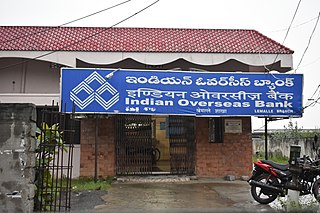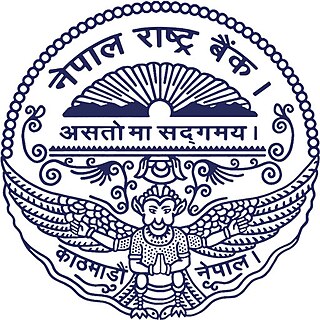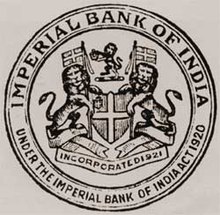
The Reserve Bank of India, abbreviated as RBI, is India's central bank and regulatory body responsible for regulation of the Indian banking system. It is under the ownership of Ministry of Finance, Government of India. It is responsible for the control, issue and maintaining supply of the Indian rupee. It also manages the country's main payment systems and works to promote its economic development. Bharatiya Reserve Bank Note Mudran (BRBNM) is a specialised division of RBI through which it prints and mints Indian currency notes (INR) in two of its currency printing presses located in Mysore and Salboni. The RBI, along with the Indian Banks' Association, established the National Payments Corporation of India to promote and regulate the payment and settlement systems in India. Deposit Insurance and Credit Guarantee Corporation was established by RBI as one of its specialized division for the purpose of providing insurance of deposits and guaranteeing of credit facilities to all Indian banks.

State Bank of India (SBI) is an Indian multinational public sector bank and financial services statutory body headquartered in Mumbai, Maharashtra. SBI is the 48th largest bank in the world by total assets and ranked 221st in the Fortune Global 500 list of the world's biggest corporations of 2020, being the only Indian bank on the list. It is a public sector bank and the largest bank in India with a 23% market share by assets and a 25% share of the total loan and deposits market. It is also the tenth largest employer in India with nearly 250,000 employees. On 14 September 2022, State Bank of India became the third lender and seventh Indian company to cross the ₹ 5-trillion market capitalisation on the Indian stock exchanges for the first time. The largest public lender in the country reached a milestone on February 7, 2024, when its market capitalization surpassed ₹6 lakh crore, making it the second public sector undertaking (PSU) to do so, after Life Insurance Corporation. The Reserve Bank of India (RBI) has identified the SBI, HDFC Bank, and ICICI Bank as Domestic Systemically Important Banks (D-SIBs), which are often referred to as banks that are “too big to fail”.

Bank of Baroda is an Indian Multinational public sector bank headquartered in Vadodara, Gujarat. It is the second largest public sector bank in India after State Bank of India, with 153 million customers, a total business of US$218 billion, and a global presence of 100 overseas offices. Based on 2023 data, it is ranked 586 on the Forbes Global 2000 list.

Bank of India (BOI) is an Indian Multinational public sector bank headquartered in Bandra Kurla Complex, Mumbai. Founded in 1906, it has been government-owned since nationalisation in 1969. BoI is a founding member of SWIFT, which facilitates provision of cost-effective financial processing and communication services.

Indian Overseas Bank (IOB) is an Indian public sector bank based in Chennai. It has about 3,220 domestic branches, 2 DBUs about 4 foreign branches and representative office. Founded in February 1937 by M. Ct. M. Chidambaram Chettyar with twin objectives of specialising in foreign exchange business and overseas banking, it has created various milestones in Indian Banking Sector. During the nationalisation, IOB was one of the 14 major banks taken over by the government of India. On 5 December 2021, IOB got Degidhan Award 2020–21 by Ministry of Electronics & Information Technology for achieving second highest percentage of digital payment transaction among public sector banks. As on 31 March 2022, IOB's total business stands at ₹417,960 crore (US$52 billion).
UCO Bank, formerly United Commercial Bank, is an Indian public sector bank, and financial services statutory body headquartered in Kolkata. UCO Bank is the 10th largest public sector bank in India by total asset and ranked 1948 in Forbes Global 2000 list of year 2018 & ranked 80 on the Fortune India 500 list in 2020. During FY 2022–23, its total business was ₹4.10 lakh crore. The market capitalisation of bank is ₹48,947.69 crore (2023).

State Bank of Hyderabad (SBH) was a regional bank in Hyderabad, with headquarters at Gunfoundry, Abids, Hyderabad, Telangana. Founded by the 7th Nizam of Hyderabad State, Mir Osman Ali Khan, it is now one of the five associate banks of State Bank of India (SBI) and was one of the nationalized banks in India. It was founded in 1941 as the Hyderabad State Bank. From 1956 until 31 March 2017, it had been an associate bank of the SBI, the largest such. The State Bank of Hyderabad was merged with SBI on 1 April 2017.

Modern banking in India originated in the mid of 18th century. Among the first banks were the Bank of Hindustan, which was established in 1770 and liquidated in 1829–32; and the General Bank of India, established in 1786 but failed in 1791.
Union Bank of India, commonly referred to as Union Bank or UBI, is an Indian public sector bank headquartered in Mumbai. It has 153+ million customers and a total business of Rs.19,84,842 Crores After the merging with Corporation Bank and Andhra Bank, which came into effect on 1 April 2020, the merged entity became one of the largest PSU banks in terms of branch network with around 8700+ branches. Four of these are located overseas in Hong Kong, Dubai, Antwerp, and Sydney. UBI also has representative offices at Shanghai, Beijing and Abu Dhabi. UBI operates in the United Kingdom through its wholly owned subsidiary, Union Bank of India (UK). The bank has a network of 8500+ domestic branches, 10000+ ATMs, 18000+ Business Correspondent Points serving over 153 million customers with 76,700+ employees.

State Bank of Patiala, founded in 1917, was an associate bank of the State Bank Group. It merged with State Bank of India on 1 April 2017. At the time of its merger, State Bank of Patiala had a network of 1445 service outlets, including 1314 branches, in all major cities of India, but most of the branches were located in the Indian states of Punjab, Haryana, Himachal Pradesh, Rajasthan, Jammu & Kashmir, Uttar Pradesh, Madhya Pradesh, Delhi, Gujarat and Maharashtra.

The Bank of Madras was one of the three Presidency Banks of British India, along with the Bank of Bengal and the Bank of Bombay. It was established on 1 July 1843 through the amalgamation of a number of existing regional banks and headquartered in Madras. It was merged with the other Presidency banks in 1921 to form the Imperial Bank of India, which later became the State Bank of India.

The Bank of Calcutta was founded on 2 June 1806, mainly to fund General Arthur Wellesley's wars against Tipu Sultan and the Marathas. It was the tenth oldest bank in India and was renamed Bank of Bengal on 2 January 1809.

The Bank of Bombay was the second of the three presidency banks of the Raj period. It was established, pursuant to a charter of the British East India Company, on 15 April 1840.
Palai Central Bank was a commercial bank headquartered in Kerala, South India that functioned during the middle of last century. Although it was started in a small, remote city, the bank grew to become not only the largest bank but the largest institution in Kerala, after the state government, and the 17th largest among the 94 scheduled banks in India. The Kerala High Court in 1960 ordered the liquidation of Palai Central Bank on a petition from the Reserve Bank of India.

George Town is a neighbourhood in Chennai, Tamil Nadu, India. It is near the Fort Saint George, Chennai. It is also known as Muthialpet and Parry's corner. It is an historical area of Chennai city from where its expansion began in the 1640s. It extends from the Bay of Bengal in the east to Park town on the west. The Fort St. George is on the south, to Royapuram in the north. The Fort St. George houses the Tamil Nadu Legislative Assembly and the Secretariat. The High court of Tamil Nadu at Chennai, Dr. Ambedkar Law College, Stanley Medical College and Hospital are located here.
Bangladesh is a developing country with an impoverished banking system, particularly in terms of the services and customer care provided by the government run banks. In recent times, private banks are trying to imitate the banking structure of the more developed countries, but this attempt is often foiled by inexpert or politically motivated government policies executed by the central bank of Bangladesh, Bangladesh Bank. The outcome is a banking system fostering corruption and illegal monetary activities/laundering etc. by the politically powerful and criminals, while at the same time making the attainment of services or the performance of international transactions difficult for the ordinary citizens, students studying abroad or through distance learning, general customers etc.
The Alliance Bank of Simla was a British-run though India-registered bank that commenced operations in Simla in 1874 under the management of James Lewis Walker. The bank was established to take over the business of the United Bank of India, established in 1866, which had operations in Simla and Umballa. Its board put the United Bank of India in voluntary liquidation on 21 March 1874, and Alliance Bank commenced operations two days later. After 49 years, Alliance Bank failed on 27 April 1923 due to speculation by its management. At the time that it failed it had 36 branches, including ones in Lahore, Lucknow, Peshawar, Rawalpindi, and Rangoon.

The Nepal Rastra Bank was established April 26, 1956 A.D. under the Nepal Rastra Bank Act, 1955, to discharge the central banking responsibilities including guiding the development of the embryonic domestic financial sector. As of now, the NRB is functioning under the new Nepal Rastra Bank Act, 2002. The functions of NRB are to formulate required monetary and foreign exchange policies so as to maintain the stability in market prices, to issue currency notes, to regulate and supervise the banking and financial sector, to develop efficient payment and banking systems among others. The NRB is also the economic advisor to the government of Nepal. As the central bank of Nepal, it is the monetary, supervisory and regulatory body of all the commercial banks. development banks, finance companies and micro-finances institutions.

Nepal SBI Bank Limited (NSBL) was the result of the first Indo-Nepal joint venture in the financial sector sponsored by three institutional promoters, namely State Bank of India (SBI), Employees Provident Fund and Agricultural Development Bank of Nepal through a memorandum of understanding signed on 17 July 1992.
The Madras Bank (1683) was a bank founded in the year 1683 in British India. The bank was the oldest bank in India.














